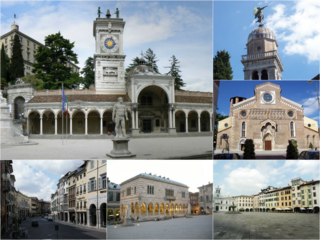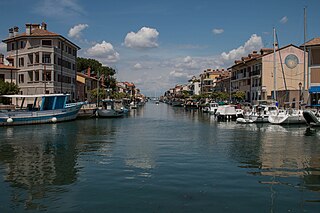
Aquileia is an ancient Roman city in Italy, at the head of the Adriatic at the edge of the lagoons, about 10 kilometres (6 mi) from the sea, on the river Natiso, the course of which has changed somewhat since Roman times. Today, the city is small, but it was large and prominent in classical antiquity as one of the world's largest cities with a population of 100,000 in the 2nd century AD and is one of the main archaeological sites of northern Italy. In late antiquity the city was the first city in the Italian Peninsula to be sacked by Attila the Hun.

Udine is a city and comune (municipality) in northeastern Italy, in the middle of the Friuli-Venezia Giulia region, between the Adriatic Sea and the Carnic Alps. It is the capital of the Regional decentralization entity of Udine. Its population was 100,514 in 2012, 176,000 with the urban area.

Gorizia (Italian pronunciation:[ɡoˈrittsja] ; Slovene: Gorica, colloquially stara Gorica 'old Gorizia' to distinguish it from Nova Gorica; Standard Friulian: Gurize, Southeastern Friulian: Guriza; Bisiacco: Gorisia; German: Görz ; is a town and comune in northeastern Italy, in the autonomous region of Friuli-Venezia Giulia. It is located at the foot of the Julian Alps, bordering Slovenia. It is the capital of the Regional decentralization entity of Gorizia and is a local center of tourism, industry, and commerce. Since 1947, a twin town of Nova Gorica has developed on the other side of the modern-day Italy–Slovenia border. The region was subject to territorial dispute between Italy and Yugoslavia after World War II: after the new boundaries were established in 1947 and the old town was left to Italy, Nova Gorica was built on the Yugoslav side. The two towns constitute a conurbation, which also includes the Slovenian municipality of Šempeter-Vrtojba. Since May 2011, these three towns have been joined in a common trans-border metropolitan zone, administered by a joint administration board.

Cividale del Friuli is a town and comune (municipality) in the Regional decentralization entity of Udine, part of the North-Italian region of Friuli-Venezia Giulia. The town lies 135 metres (443 ft) above sea-level in the foothills of the eastern Alps, 15 kilometres (9 mi) by rail from the city of Udine and close to the Slovenian border. It is situated on the river Natisone, which forms a picturesque ravine here. Formerly an important regional power, it is today a quiet, small town that attracts tourists thanks to its medieval center.

The province of Udine was a province in the autonomous Friuli-Venezia Giulia region of Italy, bordering Austria and Slovenia, with the capital in the city of Udine. Abolished on 30 September 2017, it was reestablished in 2019 as the Regional decentralization entity of Udine, and was reactivated on 1 July 2020. It has a population of 530,849 inhabitants over an area of 4,907.24 square kilometres (1,894.70 sq mi).

Duino is today a seaside resort on the northern Adriatic coast. It is a hamlet of Duino-Aurisina, a municipality (comune) of the Friuli–Venezia Giulia region of northeastern Italy. The settlement, picturesquely situated on the steep Karst cliffs of the Gulf of Trieste, is known for Duino Castle, immortalized by the poet Rainer Maria Rilke in his Duino Elegies.

Grado is a town and comune (municipality) of 8,064 residents in the Regional decentralization entity of Gorizia in the north-eastern Italian region of Friuli-Venezia Giulia, located on an island and adjacent peninsula of the Adriatic Sea between Venice and Trieste. The territory of the municipality of Grado extends between the mouth of the Isonzo and the Adriatic Sea and the Grado Lagoon, and covers an area of about 90 square kilometers between Porto Buso and Fossalon. Characteristic of the lagoon is the presence of the casoni, which are simple houses with thatched roof used in the past by the fishermen of Grado, who remained in the lagoon for a long time, returning to the island of Grado only during the colder period of the year.

The Archdiocese of Gorizia (Latin: Archidioecesis Goritiensis is a Latin archdiocese of the Catholic Church in Italy. The archiepiscopal see of Gorizia was founded in 1751 when the Patriarchate of Aquileia was abolished, and its territory divided between two new dioceses, Udine and Gorizia. The diocese of Gorizia was suppressed in 1788 for the creation of the Diocese of Gradisca and re-established in 1791 as the Diocese of Gorizia e Gradisca. It was raised again to a metropolitan archdiocese in 1830.

The flag of Friuli is the official standard of historical Friuli. A Friuli-Venezia Giulia Autonomous Regional law describes the flag as consisting of "…a rectangular standard featuring at its centre a golden heraldic eagle with outspread wings, headturned to the left, open beak and red claws, set in a sky blue field. The crest covers three fifths of the height of the flag, which in turn is two thirds of its length."

Spilimbergo is a comune (municipality) with a population of 11,961 in the Regional decentralization entity of Pordenone, in the Italian region of Friuli-Venezia Giulia. It is located on the right side of the Tagliamento river. The town is notable as the home of the Mosaic School of Friuli, which was founded in 1922 and has students from all over the world.

Attimis is a comune (municipality) in the Regional decentralization entity of Udine in the Italian region of Friuli Venezia Giulia, located about 70 kilometres (43 mi) northwest of Trieste and about 14 kilometres (9 mi) northeast of Udine.
Campolongo al Torre is a former comune of the Province of Udine in the Italian region Friuli Venezia Giulia, located about 40 km northwest of Trieste and about 25 km southeast of Udine. Since 2009 it has been one of the two principal centres of Campolongo Tapogliano, a municipality formed by its merger with the former comune of Tapogliano.

Venzone is a comune (municipality) in the Regional decentralization entity of Udine in the Italian region of Friuli Venezia Giulia. It is one of I Borghi più belli d'Italia.

The County of Gorizia, from 1365 Princely County of Gorizia, was a State of the Holy Roman Empire. Originally mediate Vogts of the Patriarchs of Aquileia, the Counts of Gorizia (Meinhardiner) ruled over several fiefs in the area of Lienz and in the Friuli region of northeastern Italy with their residence at Gorizia (Görz).

The Patria del Friuli was the territory under the temporal rule of the Patriarch of Aquileia and one of the ecclesiastical states of the Holy Roman Empire. In 1420, the Republic of Venice acquired it, but it continued to be ruled for some time under its own laws and customs.

Bertrandof Saint-Geniès was the patriarch of Aquileia from 1334 until his death.

Henry III, Count of Gorizia was a member of the Meinhardiner dynasty.

Ulrich II von Treven was Patriarch of Aquileia in northern Italy from 1161 to 1181. He supported Frederick I, Holy Roman Emperor, (1122–1190) in his unsuccessful struggle for supremacy over the northern Italian states and the papacy. He was also involved in a dispute over jurisdiction with the Patriarch of Grado where he was ultimately successful.

Kožljak is a village in Istria County, Croatia, in the municipality of Kršan. The settlement besides of the village consists of nearby homonymous medieval ruinous castle.

Karl Michael von Attems was an Austrian Catholic archbishop and a prince of the Holy Roman Empire.



































